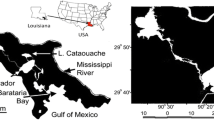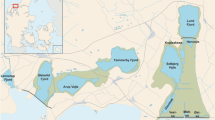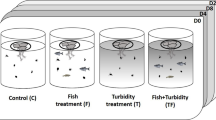Abstract
This paper describes a dilution technique for estimating the micro-zooplankton grazing impact on natural communities of marine phytoplankton. Experiments performed in coastal waters off Washington, USA (October, 1980), yield estimates of micro-zooplankton impact equivalent to 6 to 24% of phytoplankton standing biomass and 17 to 52% of production per day. Indirect evidence suggests that most of this impact is due to the feeding of copepod nauplii and tintinnids; in contrast, non-loricate ciliates, comprising 80 to 90% of numerical abundance, appeared to contribute little to phytoplankton mortality.
Similar content being viewed by others
Literature Cited
Beers, J. R., F. M. H. Reid and G. L. Stewart: Microplankton of the North Pacific Central Gyre. Population structure and abundance, June 1973. Int. Revue ges. Hydrobiol. 60, 607–638 (1975)
Beers, J. R. and G. L. Stewart: Micro-zooplankton in the euphotic zone at five locations across the California Current. J. Fish. Res. Bd Can. 24, 2053–2068 (1967)
Beers, J. R. and G. L. Stewart: Numerical abundance and estimated biomass of micro-zooplankton. In: The ecology of the plankton off La Jolla, California, in the period April through September, 1967, Part VI. Bull. Scripps Instn Oceanogr. (New Ser.) 17, 67–87 (1970)
Beers, J. R. and G. L. Stewart: Micro-zooplankters in the plankton communities of the upper waters of the eastern tropical Pacific. Deep-Sea Res. 18, 861–883 (1971)
Berk, S. G., D. C. Brownlee, D. R. Heinle, H. J. Kling and R. R. Colwell: Ciliates as a food source for marine planktonic copepods. Microb. Ecol. 4, 27–40 (1977)
Capriulo, G. M. and E. J. Carpenter: Grazing by 35 to 202 μm micro-zooplankton in Long Island Sound. Mar. Biol. 56, 319–326 (1980)
Dussart, B. M.: Les différentes catégories de plancton. Hydrobiologia 26, 72–74 (1965)
Fenchel, T.: Intrinsic rate of natural increase: the relationship with body size. Oecologia (Berl.) 14, 317–326 (1974)
Frost, B. W.: A threshold feeding behavior in Calanus pacificus. Limnol. Oceanogr. 20, 263–266 (1975)
Heinbokel, J. F.: Studies on the functional role of tintinnids in the Southern California Bight. I. Grazing and growth rates in laboratory cultures. Mar. Biol. 47, 177–189 (1978a)
Heibokel, J. F.: Studies on the functional role of tintinnids in the Southern California Bight. II. Grazing rates of field populations. Mar. Biol. 47, 191–197 (1978b)
Heinbokel, J. F. and J. R. Beers: Studies on the functional role of tintinnids in the Southern California Bight. III. Grazing impact of natural assemblages. Mar. Biol. 52, 23–32 (1979)
Johannes, R. E.: Phosphorus regeneration and body size in marine animals: micro-zooplankton and nutrient regeneration. Science, N.Y. 46, 923–924 (1964)
Lam, R. K. and B. W. Frost: Model of copepod filtering response to changes in size and concentration of food. Limnol. Oceanogr. 21, 490–500 (1976)
Lorenzen, C. J.: A method for the continuous measurement of in vivo chlorophyll concentration. Deep-Sea Res. 13, 223–227 (1966)
Parsons, T. R. and R. J. LeBrasseur: The availability of food to different trophic levels in the marine food chain. In: Marine foods chains, pp 325–343. Ed. by J. H. Steele. Edinburgh: Oliver & Boyd 1970
Rassoulzadegan, F. and M. Etienne: Grazing rate of the tintinnid Stenosemalla ventricosa (Clap & Lachm.) Jörg. on the spectrum of the naturally occurring particulate matter from a Mediterranean neritic area. Limnol. Oceanogr. 26, 258–270 (1981)
Riley, G. A.: Oceanography of Long Island Sound, 1952–1954. IX. Production and utilization of organic matter. Bull. Bingham oceanogr. Coll. 15, 324–341 (1956)
Smetacek, V.: The annual cycle of protozooplankton in the Kiel Bight. Mar. Biol. 63, 1–11 (1981)
Stoecker, D., R. R. L. Guillard and R. M. Kavee: Selective predation by Favella ehrenbergii (Tintinnia) on and among dinoflagellates. Biol. Bull. mar. biol. Lab., Woods Hole 160, 136–145 (1981)
Strickland, J. D. H. and T. R. Parsons: A practical handbook of seawater analysis, 2nd ed. Bull. Fish. Res. Bd Can. 167, 1–310 (1972)
Zeuthen, E.: Body size and metabolic rate in the animal kingdom, with special regard to the marine micro-fauna. C. r. Trav. Lab. Carlsberg (Sér. chim.) 26, 17–161 (1947)
Author information
Authors and Affiliations
Additional information
Communicated by N.D. Holland, La Jolla
Contribution No. 1237 from the School of Oceanography, University of Washington, Seattle, Washington 98195, USA
Rights and permissions
About this article
Cite this article
Landry, M.R., Hassett, R.P. Estimating the grazing impact of marine micro-zooplankton. Marine Biology 67, 283–288 (1982). https://doi.org/10.1007/BF00397668
Accepted:
Issue Date:
DOI: https://doi.org/10.1007/BF00397668




